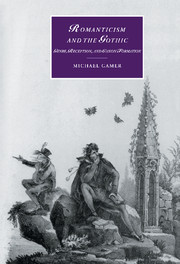Book contents
- Frontmatter
- Contents
- Acknowledgments
- List of abbreviations
- A note on the text
- Introduction: Romanticism's “pageantry of fear”
- 1 Gothic, reception, and production
- 2 Gothic and its contexts
- 3 “Gross and violent stimulants”: producing Lyrical Ballads 1798 and 1800
- 4 National supernaturalism: Joanna Baillie, Germany, and the gothic drama
- 5 “To foist thy stale romance”: Scott, antiquarianism, and authorship
- Notes
- Index
- CAMBRIDGE STUDIES IN ROMANTICISM
2 - Gothic and its contexts
Published online by Cambridge University Press: 22 September 2009
- Frontmatter
- Contents
- Acknowledgments
- List of abbreviations
- A note on the text
- Introduction: Romanticism's “pageantry of fear”
- 1 Gothic, reception, and production
- 2 Gothic and its contexts
- 3 “Gross and violent stimulants”: producing Lyrical Ballads 1798 and 1800
- 4 National supernaturalism: Joanna Baillie, Germany, and the gothic drama
- 5 “To foist thy stale romance”: Scott, antiquarianism, and authorship
- Notes
- Index
- CAMBRIDGE STUDIES IN ROMANTICISM
Summary
Walpole's Otranto and Clara Reeve's Old English Baron were literary “Gothic stories” in the second sense of the word “Gothic”; that is, they aimed at a medieval atmosphere by means of medieval background … But to the reading public the outstanding feature of these stories appears to have been, not their Gothic setting, but their supernatural incident. Imitators and followers of Walpole and Reeve, therefore, being thrifty persons, and acutely conscious of the public's taste in best sellers – for Gothic romance was the first best seller – kept accenting this spectral side of the genre more and more, because there was a market for it … The result was the logical one; the term “Gothic” itself … gradually lost all connotation of the medieval, and became at last … a literary term … post-dating the chief Gothic romancers, Walpole, Reeve, Lewis, and Radcliffe, who never used the adjective except with medieval connotation.
(Alfred Longueil, “The Word ‘Gothic’ in Eighteenth Century Criticism”)Like most terms denoting genre or periodization, “gothic” is retrospective, coined in Britain after its referents had come to dominate the shelves of circulating libraries and the boards of the London stage. Its history, however, did not evolve as one might expect. One would suspect the literary-historical tag for this “first best seller,” as was first the case for the terms “metaphysical” or “Victorian,” to be the derogatory and pejorative invention of critics and reviewers.
- Type
- Chapter
- Information
- Romanticism and the GothicGenre, Reception, and Canon Formation, pp. 48 - 89Publisher: Cambridge University PressPrint publication year: 2000

